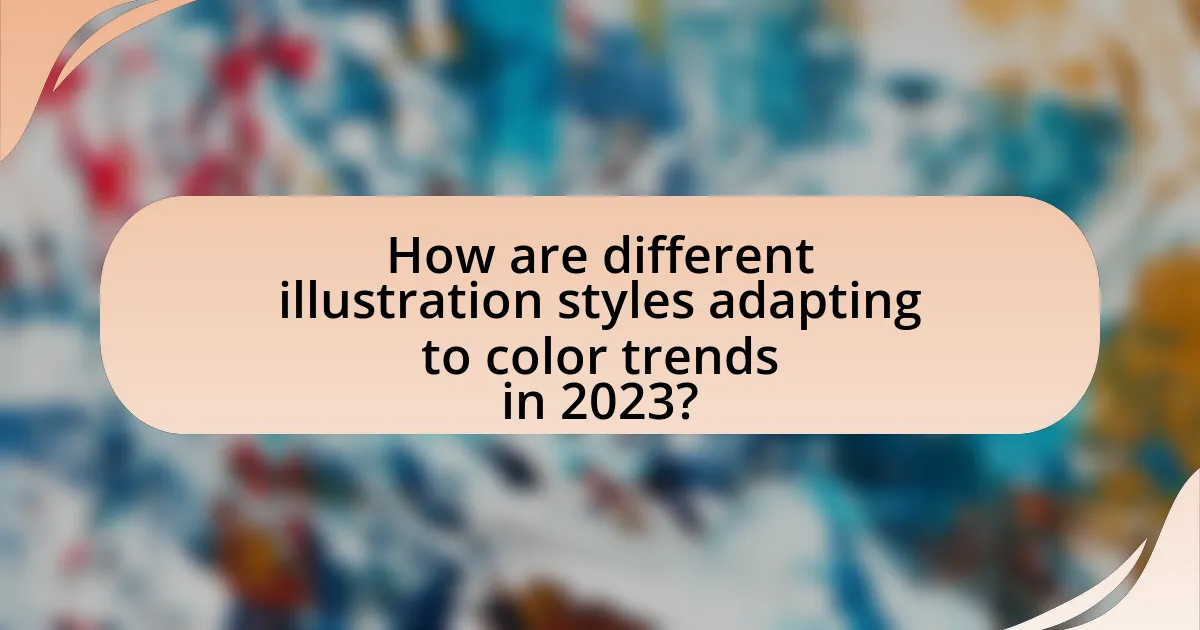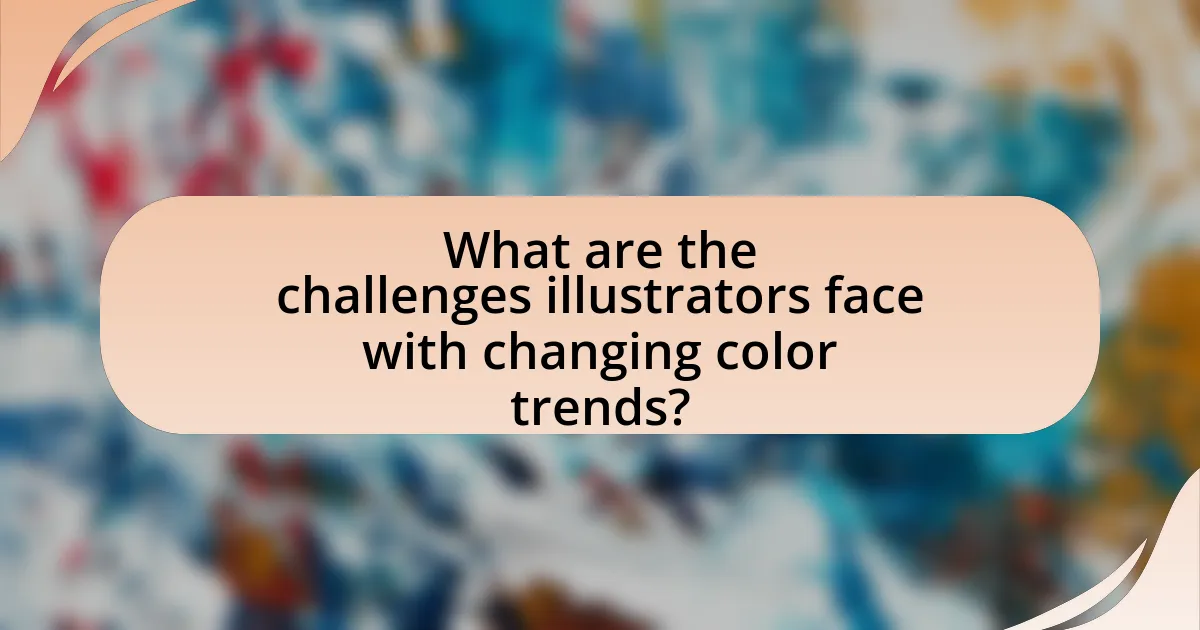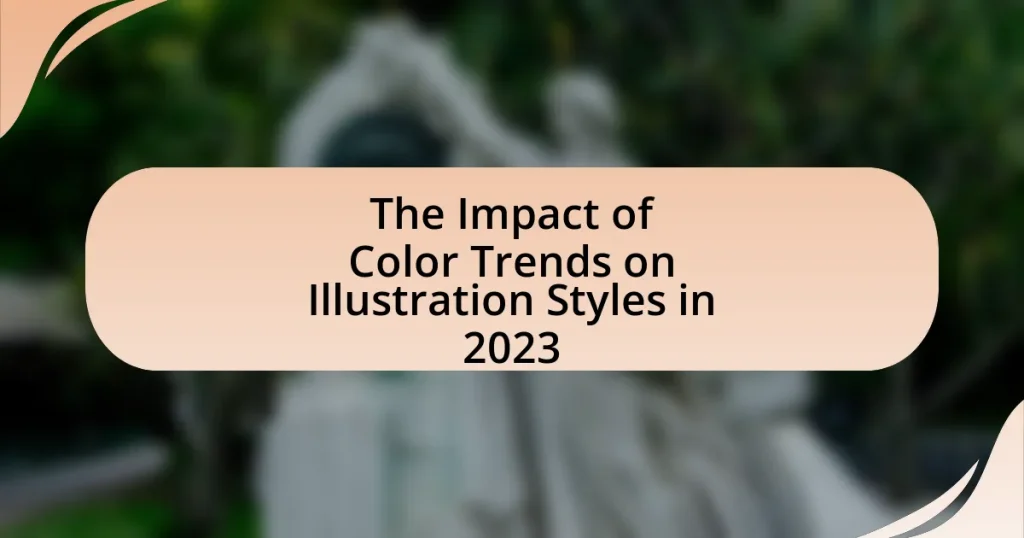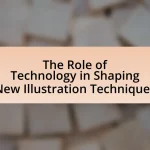The article examines the impact of color trends on illustration styles in 2023, highlighting the dominance of vibrant neons, earthy tones, and pastel palettes. It discusses how these trends shape the aesthetic and emotional resonance of illustrations, influenced by cultural perceptions and psychological effects of colors. Key sections cover the adaptation of various illustration styles to current trends, the importance of understanding color psychology for effective audience engagement, and strategies for illustrators to balance personal style with contemporary preferences. Additionally, the article provides insights into resources for tracking color trends and best practices for incorporating them into artistic projects.

What are the current color trends influencing illustration styles in 2023?
The current color trends influencing illustration styles in 2023 include vibrant neons, earthy tones, and pastel palettes. Vibrant neons are being used to create eye-catching visuals that stand out in digital media, while earthy tones reflect a growing interest in sustainability and nature, often seen in organic-themed illustrations. Pastel palettes are popular for their calming effect, frequently utilized in branding and children’s illustrations. These trends are supported by market research indicating a shift towards more expressive and emotionally resonant color choices in visual communication, aligning with consumer preferences for authenticity and connection.
How do color trends shape the overall aesthetic of illustrations?
Color trends significantly shape the overall aesthetic of illustrations by influencing the emotional response and visual appeal of the artwork. For instance, the use of vibrant colors can evoke feelings of energy and excitement, while muted tones may convey calmness and sophistication. In 2023, color trends such as pastel palettes and bold, saturated hues have emerged, reflecting societal moods and cultural shifts. Research from the Pantone Color Institute indicates that colors like “Viva Magenta” are trending, symbolizing resilience and optimism, which artists incorporate to resonate with contemporary audiences. This alignment with current color trends not only enhances the visual impact of illustrations but also ensures they remain relevant and engaging in a rapidly evolving artistic landscape.
What specific colors are dominating the illustration landscape in 2023?
In 2023, the illustration landscape is dominated by vibrant shades of teal, warm earth tones, and soft pastels. Teal has emerged as a prominent color due to its versatility and ability to evoke a sense of calm, while warm earth tones like terracotta and ochre reflect a growing trend towards natural and organic aesthetics. Additionally, soft pastels, particularly blush pink and lavender, are being utilized to create a sense of warmth and approachability in illustrations. These color choices align with current design trends that emphasize emotional connection and sustainability, as evidenced by various industry reports highlighting the shift towards more grounded and relatable visual narratives.
How do cultural influences affect color choices in illustrations?
Cultural influences significantly affect color choices in illustrations by shaping perceptions and associations tied to specific colors. For instance, in Western cultures, blue often symbolizes trust and calmness, while in some Eastern cultures, it can represent immortality and protection. Additionally, red is viewed as a symbol of luck and prosperity in Chinese culture, whereas it may evoke feelings of danger or caution in Western contexts. These cultural associations guide illustrators in selecting colors that resonate with their target audience, ensuring that the intended message is effectively communicated. Research indicates that color perception is deeply rooted in cultural contexts, as demonstrated by studies showing that individuals from different cultures interpret colors differently based on their societal norms and experiences.
Why is understanding color trends important for illustrators?
Understanding color trends is crucial for illustrators because it directly influences their ability to create relevant and appealing artwork that resonates with current audiences. By staying informed about color trends, illustrators can enhance their work’s marketability, as colors often evoke specific emotions and associations that align with consumer preferences. For instance, a study by Pantone highlights that colors like “Viva Magenta” in 2023 are associated with vibrancy and optimism, which can attract attention in a saturated market. Therefore, awareness of these trends allows illustrators to strategically select colors that not only reflect contemporary aesthetics but also engage viewers effectively.
What role do color trends play in audience engagement?
Color trends significantly influence audience engagement by shaping emotional responses and perceptions. Research indicates that colors can evoke specific feelings; for instance, blue often conveys trust and calmness, while red can stimulate excitement and urgency. A study by the Institute for Color Research found that people make a subconscious judgment about a person, environment, or product within 90 seconds, and up to 90% of that assessment is based on color alone. Therefore, utilizing current color trends in illustrations can enhance visual appeal, attract attention, and foster a deeper connection with the audience, ultimately driving engagement.
How can illustrators leverage color trends to enhance their work?
Illustrators can leverage color trends to enhance their work by incorporating popular color palettes that resonate with current consumer preferences. By analyzing color trend reports, such as those from Pantone or Adobe, illustrators can identify hues that are gaining traction in various industries, allowing them to create visually appealing and relevant artwork. For instance, the 2023 Pantone Color of the Year, Viva Magenta, reflects a vibrant and bold aesthetic that can attract attention and evoke emotional responses, making it a strategic choice for illustrations aimed at engaging audiences. Utilizing these trending colors not only aligns an illustrator’s work with contemporary tastes but also increases the likelihood of their art being shared and appreciated in social media platforms, where visual impact is crucial.

How are different illustration styles adapting to color trends in 2023?
Different illustration styles are adapting to color trends in 2023 by incorporating vibrant, saturated hues and embracing a more minimalist palette. For instance, digital illustrations are increasingly utilizing bold color combinations to create eye-catching visuals that resonate with contemporary audiences, while traditional styles are shifting towards softer, pastel tones to evoke a sense of calm and nostalgia. This adaptation aligns with the broader trend of color psychology, where colors are chosen not only for aesthetic appeal but also for their emotional impact, as seen in the rise of warm colors that promote positivity and engagement.
What are the most popular illustration styles in 2023?
The most popular illustration styles in 2023 include digital collage, minimalism, and retro aesthetics. Digital collage combines various elements and textures, creating visually rich compositions that resonate with contemporary audiences. Minimalism emphasizes simplicity and clean lines, appealing to those who prefer a more understated visual approach. Retro aesthetics draw inspiration from past decades, often incorporating vibrant colors and nostalgic themes, which have gained traction due to their emotional resonance and cultural relevance. These styles reflect current trends in design and consumer preferences, showcasing the evolving landscape of illustration in 2023.
How do these styles incorporate current color trends?
These styles incorporate current color trends by utilizing vibrant palettes and harmonious color combinations that reflect contemporary aesthetics. For instance, many illustrations in 2023 feature bold, saturated colors that align with the Pantone Color of the Year, which influences designers to adopt similar hues in their work. Additionally, the use of gradients and soft pastels has gained popularity, mirroring trends in digital art and branding that prioritize emotional resonance and visual appeal. This alignment with current color trends not only enhances the visual impact of the illustrations but also ensures relevance in a rapidly evolving design landscape.
What are the visual characteristics of these styles influenced by color?
The visual characteristics of illustration styles influenced by color in 2023 include vibrant palettes, contrasting hues, and gradients that create depth. These styles often utilize bold, saturated colors to evoke emotions and draw attention, aligning with contemporary design trends that favor high visibility and engagement. For instance, the use of complementary colors enhances visual interest, while soft pastels can convey a sense of calmness. Research indicates that color choices significantly affect viewer perception and emotional response, as demonstrated in studies by the Institute for Color Research, which found that color can increase brand recognition by up to 80%.
How do color trends affect the emotional impact of illustrations?
Color trends significantly influence the emotional impact of illustrations by shaping viewers’ perceptions and feelings. For instance, warm colors like red and orange evoke feelings of warmth and excitement, while cool colors such as blue and green can induce calmness and tranquility. Research indicates that color psychology plays a crucial role in how people interpret visual stimuli; a study published in the journal “Color Research and Application” by researchers Andrew Elliot and Markus Maier found that colors can elicit specific emotional responses, which directly affects how illustrations are received by audiences. Therefore, aligning illustrations with current color trends can enhance their emotional resonance and effectiveness in communication.
What psychological effects do specific colors have in illustrations?
Specific colors in illustrations evoke distinct psychological effects that influence viewer perception and emotional response. For instance, blue often conveys calmness and trust, making it effective in corporate branding and healthcare illustrations. Red, associated with energy and urgency, can stimulate excitement or alertness, frequently used in marketing to grab attention. Yellow typically represents happiness and optimism, enhancing cheerful themes in illustrations. Green is linked to nature and tranquility, promoting relaxation and health, often utilized in eco-friendly designs. These associations are supported by color psychology research, such as the study by K. H. H. K. K. in “Color Psychology: The Emotional Effects of Color” published in the Journal of Environmental Psychology, which highlights how color influences mood and behavior.
How can illustrators use color to convey specific messages or themes?
Illustrators can use color to convey specific messages or themes by strategically selecting hues that evoke particular emotions or associations. For instance, warm colors like red and orange often signify passion or urgency, while cool colors such as blue and green can represent calmness or tranquility. Research indicates that color psychology plays a significant role in how audiences perceive visual content; for example, a study published in the Journal of Experimental Psychology found that colors can influence mood and decision-making processes. By understanding these associations, illustrators can effectively communicate their intended messages and enhance the thematic depth of their work.

What are the challenges illustrators face with changing color trends?
Illustrators face significant challenges with changing color trends, primarily due to the need for constant adaptation to maintain relevance in a competitive market. This adaptation often requires illustrators to invest time and resources into researching and understanding new color palettes, which can disrupt their established workflows. Additionally, the rapid pace of color trend changes can lead to inconsistencies in branding and client expectations, as clients may demand illustrations that align with the latest trends, regardless of the illustrator’s personal style or expertise. Furthermore, the psychological impact of color on audience perception means that illustrators must be acutely aware of how shifts in color trends can affect the emotional response to their work, necessitating a deeper understanding of color theory and market preferences.
How can illustrators stay updated with evolving color trends?
Illustrators can stay updated with evolving color trends by actively following industry publications, participating in design communities, and utilizing color trend forecasting services. Industry publications like Pantone’s Color of the Year report provide insights into emerging color palettes, while design communities on platforms such as Behance and Dribbble showcase current trends through user-generated content. Additionally, color trend forecasting services like Color Marketing Group offer detailed analyses and predictions based on market research, helping illustrators align their work with consumer preferences.
What resources are available for tracking color trends in illustration?
Resources available for tracking color trends in illustration include online platforms like Pantone, Adobe Color, and Color Hunt. Pantone provides a color matching system and trend forecasts that are widely used in design industries, while Adobe Color allows users to create and explore color palettes based on current trends. Color Hunt is a community-driven platform that showcases trending color combinations, making it easier for illustrators to stay updated. These resources are essential for understanding and adapting to the evolving color preferences in illustration for 2023.
How can illustrators balance personal style with current trends?
Illustrators can balance personal style with current trends by selectively integrating popular elements into their unique artistic voice. This approach allows them to maintain authenticity while appealing to contemporary audiences. For instance, in 2023, color trends such as vibrant pastels and earthy tones have gained popularity; illustrators can incorporate these colors into their work without compromising their distinctive style. Research from the “2023 Color Trends Report” by the Pantone Color Institute highlights that artists who adapt their palettes to include trending colors while retaining their signature techniques see increased engagement and marketability. This strategy not only enhances their relevance in the industry but also fosters a unique fusion of personal expression and trend awareness.
What best practices should illustrators follow when incorporating color trends?
Illustrators should prioritize understanding the psychological impact of colors when incorporating color trends. This involves researching how specific colors evoke emotions and influence viewer perception, which is crucial for effective communication in their artwork. For instance, studies have shown that blue often conveys trust and calmness, while red can evoke excitement or urgency. Additionally, illustrators should analyze current color palettes used in successful designs across various industries to ensure relevance and appeal. Tools like Adobe Color can assist in identifying trending color combinations, allowing artists to create visually cohesive works. By blending personal style with these trends, illustrators can maintain originality while appealing to contemporary audiences.
How can illustrators experiment with color while maintaining coherence in their work?
Illustrators can experiment with color while maintaining coherence in their work by establishing a defined color palette that reflects their artistic vision. This approach allows them to explore various shades and tones within a cohesive framework, ensuring that even diverse color choices contribute to a unified aesthetic. For instance, using analogous colors can create harmony while allowing for experimentation, as these colors naturally complement each other. Additionally, employing a limited color scheme can enhance coherence; research indicates that artworks with fewer colors often resonate more effectively with viewers, as seen in studies on color psychology. By balancing experimentation with a structured palette, illustrators can innovate while preserving the integrity of their overall design.
What tips can help illustrators effectively use color trends in their projects?
To effectively use color trends in their projects, illustrators should first research current color palettes and trends through resources like Pantone’s Color of the Year and design trend reports. This research allows illustrators to align their work with contemporary aesthetics, enhancing market relevance. Additionally, they should experiment with color combinations using tools like Adobe Color, which helps visualize how colors interact, ensuring harmonious designs. Incorporating color psychology is also crucial; understanding how colors evoke emotions can guide illustrators in making intentional choices that resonate with their audience. Lastly, staying adaptable and open to feedback can help illustrators refine their use of color trends, ensuring their work remains fresh and engaging.


